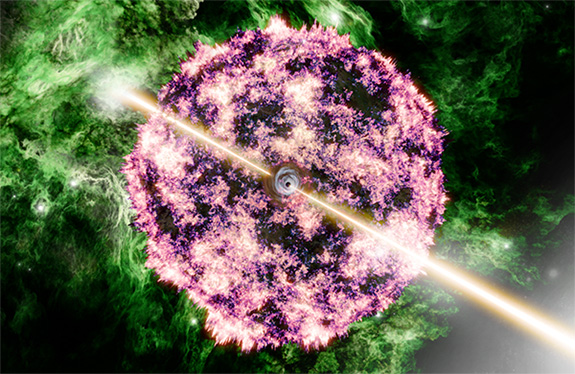Back in October of 2017, thousands of astronomers from around the globe joined together to confirm the first-ever sighting of two neutron stars colliding in space. In just one second, the “kilonova” located 130 million light-years from Earth in the constellation Hydra triggered the equivalent of 50 Earth masses of silver, 100 Earth masses of gold and 500 Earth masses of platinum.
The scientists estimated that the gold alone was worth more than $100 octillion. That’s $100,000,000,000,000,000,000,000,000,000 (1 followed by 29 zeroes).
The astronomers aimed their equipment at the super-dense kilonova, looking for the signatures of heavy metals. They recorded visible light, radio waves, X-rays and gamma rays. The data confirmed the birth of massive amounts of precious metals and seemed to put to rest the long-standing mystery of how these and other “heavy” elements are formed.
A newly published study, however, is challenging conventional wisdom and deepening the mystery.
Northwestern University researchers using NASA’s James Webb Space Telescope (JWST) to study a mammoth stellar collapse were stunned when they found absolutely no evidence of heavy elements.
The collapse, first registered on October 9, 2002, resulted in the brightest gamma-ray burst (GRB) ever recorded. Scientists gave it the nickname B.O.A.T. (“brightest of all time”).
“When we confirmed that the GRB was generated by the collapse of a massive star, that gave us the opportunity to test a hypothesis for how some of the heaviest elements in the universe are formed,” said Northwestern’s Peter Blanchard, who led the study.
“We did not see signatures of these heavy elements, suggesting that extremely energetic GRBs like the B.O.A.T. do not produce these elements. That doesn’t mean that all GRBs do not produce them, but it’s a key piece of information as we continue to understand where these heavy elements come from. Future observations with JWST will determine if the B.O.A.T.’s ‘normal’ cousins produce these elements.”
“This event is particularly exciting because some had hypothesized that a luminous gamma-ray burst like the B.O.A.T. could make a lot of heavy elements like gold and platinum,” added second author Ashley Villar of Harvard University and the Center for Astrophysics | Harvard & Smithsonian. “If they were correct, the B.O.A.T. should have been a gold mine. It is really striking that we didn’t see any evidence for these heavy elements.”
The findings were published last week in the journal Nature Astronomy.
According to a Northwestern University press release, the powerful B.O.A.T. explosion occurred approximately 2 billion light-years from Earth, in the direction of the constellation Sagitta and lasted a few hundred seconds. It was so bright that it saturated most of the world’s gamma-ray detectors.
“The event produced some of the highest-energy photons ever recorded by satellites designed to detect gamma rays,” Blanchard said. “This was an event that Earth sees only once every 10,000 years. We are fortunate to live in a time when we have the technology to detect these bursts happening across the universe.”
Credit: Image by Aaron M. Geller / Northwestern / CIERA / IT Research Computing and Data Services.

No comments:
Post a Comment